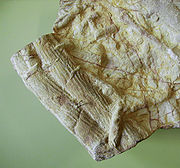
Cruziana
Encyclopedia

Trace fossil
Trace fossils, also called ichnofossils , are geological records of biological activity. Trace fossils may be impressions made on the substrate by an organism: for example, burrows, borings , urolites , footprints and feeding marks, and root cavities...
consisting of elongate, bilobed, approximately bilaterally symmetrical burrows, usually preserved along bedding planes, with a sculpture of repeated striations that are mostly oblique to the long dimension. Trace fossils can reveal many aspects of their makers' behavior, and work on Cruziana has been extensive.
The makers of Cruziana are mainly considered to have been trilobite
Trilobite
Trilobites are a well-known fossil group of extinct marine arthropods that form the class Trilobita. The first appearance of trilobites in the fossil record defines the base of the Atdabanian stage of the Early Cambrian period , and they flourished throughout the lower Paleozoic era before...
s; since they appear in the non-marine Beacon sandstone
Beacon sandstone
The Beacon sandstone is a geological formation exposed in Antarctica and deposited from the Devonian to the Triassic . The sandstone was originally described as a formation, and upgraded to group and supergroup as time passed. It contains a sandy member known as the Beacon heights...
, and Triassic deposits (after trilobites went extinct [Permian]) they must also have been made by other arthropods. In some cases, the burrow begins or ends with a resting trace, called Rusophycus
Rusophycus
Rusophycus is a trace fossil allied to Cruziana. Rusophycus is the resting trace, recording the outline of the tracemaker; Cruziana is made when the organism moved...
, whose outline corresponds roughly to the outline of the tracemaker, and whose sculpture may reveal the approximate number of legs, although striations (scratchmarks) from a single leg may overlap or be repeated. Several specimens of Cruziana are commonly found associated together at one sedimentary horizon, suggesting that they were made by populations of trilobites.
Cruziana can reach 15mm across and 15 cm in length, with one end usually deeper and wider than the other.
The trace fossil is found in marine and freshwater environments. It has uses in biostratigraphy; certain scratch patterns are unique to certain time intervals.
External links
- Trackways and associated burrow; Photo--(Close-up); Graphic--(trilobite and burrow, etc)
- Argentine article on Cruziana "Remarkable Cruziana beds in the Lower Ordovician of the Cordillera OrientalCordillera OrientalCordillera Oriental from the Spanish language meaning "Eastern range" may refer to:* Cordillera Oriental * Cordillera Oriental * Cordillera Oriental * Cordillera Oriental -See also:...
, NW ArgentinaArgentinaArgentina , officially the Argentine Republic , is the second largest country in South America by land area, after Brazil. It is constituted as a federation of 23 provinces and an autonomous city, Buenos Aires...
".

